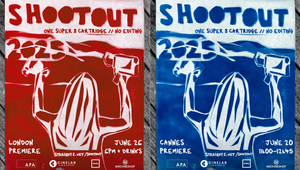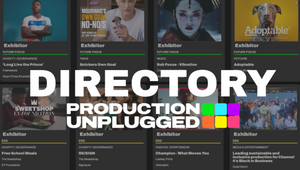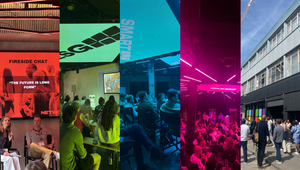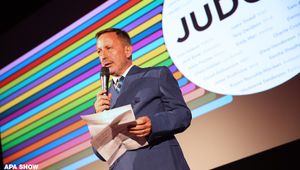
How ARRI Demonstrated the Power of Virtual Production

According to the Advertising Producers Association (APA), there is a gap between the aspirations of productions and the realities of using new, evolving technologies that are all under the umbrella of VFX. To some extent that could be born out of a misunderstanding on when virtual production should come into play in order for it to reach its full potential, or when it is necessary to elevate a production. “Virtual production is also being led by technology and hardware brands, when it now needs to be led by the creative and the ideology of ‘look what this technology can do for us’,” stated the APA.
This is why in January, the APA co-hosted an event at the ARRI and Creative Technology LED volume space (ARRI Stage London) to showcase the sheer creative versatility of virtual production, as well as the extent to which it can help or mend the production pipeline. At the full day event, consisting of two sessions, members of the association were invited to explore the capabilities of VR within the production industry through an immersive exhibition.
Led by Robert Payton, cinematographer and virtual production consultant, alongside Will Case, director of innovation at Creative Technology, the conversation spanned a few specialisms within virtual production, which then led to an open stage of demonstration. At the start of the talk, Robert and Will briefed the audience on the significance of VR within production, spanning the many advantages it brings, including time and cost savings, post-production efficacy, enhanced sustainability on set, and a better environment for actors.
Starting the live demonstration, Robert explained to the audience the significance of the in-vision wall, and highlighted the importance of the out of vision walls, and ceiling for creating reflections and providing volumetric lighting. The in-vision wall is a 30 metre-long and five metre-high LED wall, bent at 270°. Robert explained the importance of combining background and foreground elements to create ICVFX, along with the benefits of working in the volume over green screen

Then, a naturalistic set on rollers was brought in and the in-vision wall became a natural summer backdrop to the set with a few props also placed on set to add texture. All of this came together in less than a minute. On the set, the two subjects - a boy and a girl - were becoming increasingly immersed in the created environment. The camera pointing at them, connected to the in-vision wall, was able to track the movement of the camera operator and place the objects within the extended reality of the wall, moving the background so that they appeared immersed in the forest environment. The demonstration proved that this seamless blending into the background, with the help of extended reality technology, is what makes the true difference between sustainable and non-sustainable production, especially when a crew needs to move through five or more different sets for one commercial.
Will Case of Creative Technology also explained the importance of layering when creating an entirely in-camera setting, in order to keep the realism. Using props in the foreground and behind the subjects of the scene, smoke machines (which were also demonstrated on the set), correct usage of light, combined with an impeccable production of a movable set from the art department, are all necessary assets to create a great end product. The demonstration also showed the ease with which the set can change itself between an equally realistic summer day, night, sunset, sunrise, or any imaginable season.

Next in the demonstration, the ARRI team brought in a car, on another rolling set, and explained the scope with which virtual reality can operate in the automotive sector. “There is an obsession with making everything feel hyper-real. Filmmaking isn’t making reality, it’s being able to create an image and storytelling,” said Will, when talking about why some car scenes are better to be shot in the studio, over trying to shoot them outside.
The team then recreated a tunnel in LA (a space in the real world which they explained is no longer available for shooting), but which had been recorded using photogrammetry and lidar scanning before it was closed for filming. Not only does that eliminate the need to close off a real life location, and travel to California, but also eliminates the tedious procedures the crew would have to go through before placing the talent into a moving car in the real world, which presents unavoidable risk.
Instead, the demonstrators explained that with technology, they have a space now closed off for shooting at their disposal at any time of day or night, with no risks attached. “I’ve spent 20 years of my life shooting cars, and it is a nightmare,” said Will, talking about the recurring struggles that directors and producers face when trying to shoot cars in different locations, including embargoes and health and safety issues. “Here, I can shoot all day long, with a car, in a very secure way.”
In addition to this there is the added benefit of being able to have the director standing next to the car and directing the talent inside, without having to stop and reshoot scenes as you would in the outside world, which is also a great help to the talent, as they are able to perform to their best ability and interact with the virtual space around them.
“We’ve shot so many different cars here across multiple locations in just a matter of days - from a Greyhound bus with 20 people in it to a helicopter! ” the crew told us. The team then demonstrated taking the car-in-tunnel demonstration to the next level by adding a realistic sound of the tunnel alongside real effects on-set including dust and water droplets being sprayed manually over the windscreen of the car.
The demo session continued by showing the ease at which a director can change anything from the time of day, the way light hits the face of the talent inside a moving car, or how the amount of dust, smoke, or any ‘naturally occurring’ texture interacts with a scene. It truly emphasised the effectiveness and importance of virtual environments and extended reality in modern-day production, which ticks all the boxes that producers and directors require, from budget management and time saving, to sustainability tracking and the ability to produce something that, simply put, is just not possible in the real world.













